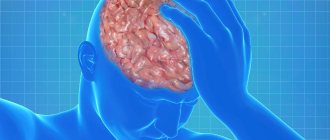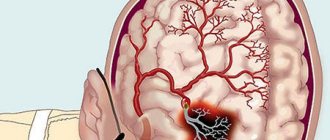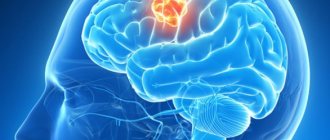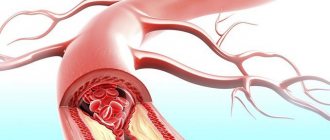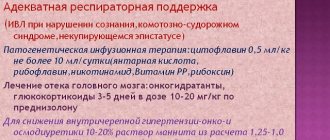- home
- Diseases
At the moment, the number of known diseases is so huge that it boggles the mind. Many of them have very similar symptoms, and sometimes even the mechanism of development, but in reality they are different diseases with different treatments. With the advent of modern benefits of civilization, the world of people began to spin faster, but now people have become less active and less supportive of a healthy lifestyle. All this accordingly leads to the development of diseases of the heart, blood vessels, musculoskeletal system, lungs, and the like. The most common complication of such life activity is venous stagnation. Many have heard about this complication, but what is it? Let's break this disease down into pieces.
Classification of venous circulation
Venous discirculation is divided into three stages:
- Latent stage - the initial stage without symptoms.
- Cerebral venous dystonia is a stage with non-dangerous symptoms.
- Venous encephalopathy is a stage when the patient’s vital functions are disrupted.
The scientist Berdichevsky identified 2 main forms of disorder: primary and stagnant.
- Primary - slow blood circulation due to decreased venous tone.
- Congestive - the appearance of a mechanical barrier (thrombi) that prevents normal blood circulation.
Signs and symptoms of venous discirculation
A dull headache, especially pronounced in the morning, is the main defining symptom of the disease.
All symptoms of the disease:
- Numbness of the limbs;
- Noise in the head;
- Deterioration of vision;
- Dizziness;
- Fainting;
- Darkening in the eyes;
- Regular sleepiness;
- Severe aphasia (speech impairment).
Symptoms intensify in the autumn and spring seasons due to the body's adaptation to changing weather. Signs of the disease can manifest themselves after a head injury, hypertension, diseases of the endocrine system, alcohol and tobacco poisoning.
Symptoms
Many of us take periodic headaches very lightly, but this is wrong. Dizziness and headache are among the first symptoms of this terrible disease. Most patients describe the same clinical picture: it is difficult to wake up in the morning, a dull headache immediately appears after sleep, spots in the eyes, getting out of bed is accompanied by dizziness, the body feels wobbly. In a horizontal position, the condition worsens sharply, numbness and tingling in certain parts of the body occur. Such people sense weather changes and pressure changes in advance.
If these symptoms are ignored, over time the face takes on a characteristic appearance: it becomes bluish, the nasolabial triangle swells, and the eyelids seem constantly swollen. Vision deteriorates significantly due to swelling of the optic nerve and dilated veins of the fundus. Patients often experience fainting. In severe cases, the psyche suffers, the person loses orientation in space, and sometimes epileptic seizures occur. During periods of exacerbation, a person cannot get out of bed, severe headaches and nausea occur. All these complaints clearly indicate that the venous outflow is impaired.
Survey
Patients diagnosed with venous dyscirculation first contact a cardiologist. A competent specialist, having assessed the symptoms, history of life and illness, genetic predisposition, will prescribe a consultation with a neurologist (this is the main specialist in this field) and a number of necessary studies:
- Blood pressure monitoring with keeping a diary “Measurement of blood pressure twice a day with a recording of the accompanying symptoms.”
- X-ray of the skull. An experienced specialist will describe the signs of dilation of blood vessels and sinuses.
- Phlebography. You can see and evaluate the patency of blood vessels, how difficult the outflow of blood is.
- Magnetic resonance imaging is the most detailed study that will allow us to judge not only the state of the vascular system, but also the brain itself, which means it may help to find out the cause of the disease.
Such patients should also be observed by an ophthalmologist. Changes in the fundus indicate obstructed blood flow .
Treatment of the disease
For comprehensive and complete treatment, ophthalmoscopy, computed tomography or magnetic resonance imaging is performed.
Medicinal methods
Antiplatelet drugs are used to eliminate blood clots:
- Tirofiban;
- Aspirin;
- Glycine;
- Aklotin;
- Dipyridamole;
- Lamifiban;
- Plidol.
The dosage regimen and dosage are prescribed by the doctor.
Traditional methods of treatment
Red clover tincture helps with noise in the head and dizziness. Fill a liter jar to the top with flowers, then fill with 1 liter of quality vodka. The tincture needs to stand for 10-15 days in a dark and cool place. Afterwards use 1 tbsp. before meals 3 times a day for 2 months.
Sweet clover improves blood circulation and prevents blood thickening. Brew it like regular tea and drink 1-2 times a day for a month.
Unreasonable stimulation of blood circulation leads to hemorrhage. In order not to cause harm, traditional methods are used at the initial stage of the disorder.
Exercise stress
In most cases, venous stagnation is dealt with by regular physical activity - neck stretching, yoga, walking, morning exercises, etc. For patients, 2-3 weeks of regular exercise for 10-15 minutes 2 times a day is enough.
Exercises should be performed without overexertion and with ease, otherwise dizziness, darkening of the eyes or lightheadedness may occur.
Venous congestion of cerebral vessels
Home / Health / Venous congestion of cerebral vessels /
Venous congestion of cerebral vessels is manifested by an imbalance of metabolism and an increase in intracranial pressure.
● Medical doctors usually pay attention to the saturation of the brain with oxygen and do not attach importance to the outflow of blood. By the way, only in the absence of venous stasis in the brain are normal indicators of intracranial pressure and metabolic balance maintained. At first, difficulties in the outflow of blood do not manifest themselves in any way, and patients do not notice the pathological changes that have arisen. But there comes a period when the body is no longer able to compensate for these disruptions, and patients turn to a medical facility with complaints of headaches, tinnitus, which increases with physical activity and sudden changes in ambient temperature, and swelling under the eyes.
● Basically, venous congestion is secondary in nature, being, as it were, an addition to the underlying disease. When examining such patients, congestion in the vessels of the fundus, osteochondrosis and a violation of the psychological state are revealed. To clarify the diagnosis and determine the condition of the cerebral vessels, a rheoencephalogram and Doppler ultrasound of the arteries are performed.
Venous congestion of the brain. Conservative treatment
● If significant changes are detected in the walls of blood vessels, venous congestion can be overcome with the help of medications. Usually the doctor prescribes treatment using several drugs, since each of them acts selectively. To reduce intracranial pressure, aminophylline is used (24 mg/l intravenously), caffeine 2-3 times a day, 100-200 mg (to increase lost ability to work). Troxevasin tones the vascular muscles (increases blood fluidity), and venoruton effectively affects the capillaries. Stugeron and Prodectin improve microcirculation of blood flow.
● The attending physician also prescribes diuretics for cerebral venous congestion: glycerin, furosemide and mannitol. To reduce the distensibility of veins and ensure lymphatic drainage, venotonics are used - aescusan, phlebodia 600 and detralex.
● One of the causes of cerebral circulation disorders and venous stagnation of the brain are pathological changes in the muscles of the neck and head, which compress the blood vessels. To relax the spasm of these tense muscles, self-massage of the collar area is used, which prevents excess blood in the vessels of the head. You should massage with smooth and wide caressing movements of both hands from top to bottom, first the back surface of the neck, then its sides and the front part, alternately with one hand or the other.
Attention! Vital centers are located in the collar area of the neck - incorrect movements during a massage can cause irreparable harm. Therefore, you need to trust a specialist - a neurologist.
Venous congestion of the brain. Traditional medicine recipes.
● Compared to “chemistry,” the main advantage of medicinal plants is their versatility. The content of numerous active substances provides a comprehensive treatment of cerebral venous congestion. Moreover, medicinal herbs are absorbed better than synthetic drugs. If you combine several herbs, they will complement each other. You can treat cerebral venous congestion by using medicinal preparations based on medicinal plants, purchased at the pharmacy at any time of the year.
● Aqueous extract of Ginkgo biloba leaves is used 2 ml intravenously. After 10 days of taking this drug, the patient is freed from venous congestion due to cervical osteochondrosis, tinnitus, and his hearing improves significantly.
● Take 15 drops per ⅓ glass of water half an hour before meals, tincture of hawthorn with rose hips. This effective drug dilates blood vessels (including capillaries), has an anti-sclerotic effect and enhances muscle contraction.
● There is a strong diuretic - orthosiphon, or as it is popularly called, cat's whisker. In the pharmacy it is called kidney tea, which should be taken for six months or longer with 7-day breaks every month. You can prepare this infusion at home. Brew 1-2 teaspoons of orthosiphon leaves in half a liter of boiling water for two hours and drink half a glass of warm tea before meals 3-4 times a day.
● If venous stagnation of the brain is not expressed, when the patient feels as if his head is filled with heaviness, pressing on the back of the head and eyes, an infusion of the fruits or roots of garden parsley or its powder helps well. The powder can be purchased at a pharmacy and taken before meals 3-5 times a day, 0.5-1.0 g, with boiled warm water. You can also prepare medicine at home from the fruits or roots of parsley: infuse one tablespoon of the raw material in two glasses of boiling water for 8-10 hours and take 1 tbsp. spoon throughout the day.
● To get rid of heaviness in the head caused by venous congestion of the brain, the following plants are used in folk medicine: birch buds, parsnips, dandelion and licorice roots, cherry stalks, thyme and burdock. They can be used individually or assembled, combining in equal proportions.
● To relieve swelling, prepare this recipe. Leave for two hours 1-2 tbsp. spoons of meadowsweet herb (meadowsweet) in 400 ml of boiling water and drink half a glass warm before meals three times a day. This is an effective remedy for headaches.
● The herb Melilot officinalis is good at relieving the effects of venous congestion of cerebral vessels. Simmer two tablespoons of raw material in 200 ml of boiling water in a water bath for 15 minutes, filter after 45 minutes and drink ⅓ glass three times a day.
● An infusion of bearberry leaves (bear ears) has the same effect. 1 tbsp. Infuse a spoonful of raw material in a glass of boiling water for two hours and drink a tablespoon 3-4 times a day as a diuretic before meals.
● Our ancestors removed excess fluid and swelling of the body using an infusion of corn silk: 1-2 tbsp per glass of boiling water. spoons of raw materials, adding a couple of tablespoons of honey; drink 1-3 tbsp. spoons.
● The most effective recipe using a complex of decongestant herbs. Infuse two tablespoons of a medicinal mixture of herbs in 0.5 liters of boiling water for 2 hours: marsh cinquefoil, sage, tansy, bedstraw, taken in equal parts. Leave for two hours and filter. Use 1 tbsp. spoon every half hour if there is heaviness in the head.
● There is another collection option: yellow sweet clover, wild strawberry and birch buds, taken equally. Brew a tablespoon of the mixture with a glass of boiling water and soak for 15 minutes in a water bath. Filter and drink ⅓ glass three times a day before meals.
Venous congestion of the brain. Preventive actions.
● To alleviate the condition of a patient with venous congestion of the brain, traditional medicine recommends following a diet, reducing the consumption of table salt, excluding spicy, smoked and fried foods, coffee and strong tea from the daily diet. Eat often - every two hours and no later than two hours before bed. Rolled oats porridge cooked in water without sugar and salt effectively relieves any type of edema.
● Saturate your diet with vegetables and fruits to remove excess fluid from the body. And the last recommendation: do not self-medicate, consult your doctor when using any medicines, including those of herbal origin.
Recommended news
- Health 09/04/2020
Inhale-exhale: learning to cope with stress
- Health 08/31/2020
The role of antioxidants in the prevention of various diseases
- Health 08/29/2020
Strategies to Help Keep Your Brain Healthy for Years to Come
- Health 08/18/2020
Why is it so important to drink enough water?
- Health 08/22/2020
Purgation
- Health 08/03/2020
What your skin color says about your health
What are venotonics
Venotonics are modern medications aimed at improving blood flow. In addition to treatment, they are also suitable for prevention.
Venotonics for narrowing of veins and osteochondrosis in the head and neck area are used as an auxiliary treatment in complex therapy.
Venotonics include:
- Aescusan in the form of a gel or cream;
- Ginkor - gel;
- Dr. Theiss;
- Anavenol;
- Antistax;
- Detralex.
Medical leeches are an alternative to venotonics; they have a venotonic effect and help get rid of blood clots.
Disorders with cervical osteochondrosis
Disruption of venous outflow in cervical osteochondrosis occurs due to the fact that the movement of blood is hampered by displaced vertebrae and muscles - the blood cannot supply oxygen and useful elements to the brain, resulting in symptoms:
- Weakened vision;
- Numbness of hands;
- Sharp or dull headache;
- Pallor;
- Throbbing eye pain;
- Loss of consciousness in severe cases.
To correct the situation, it is necessary to undergo a full course of treatment for cervical osteochondrosis.
Particulars and nuances: symptoms and signs
The clinical picture of thrombosis of superficial cerebral veins usually combines neurological symptoms with characteristic signs of inflammatory, especially infectious, damage (with hyperthermia, an “inflammatory” reaction in the blood and cerebrospinal fluid).
Often the disease “debuts” with a headache with nausea and vomiting, impaired consciousness (almost always with psychosomatic agitation), which serves as a background for the development of focal brain symptoms (paralysis or paresis of the limbs, aphasia, generalized or focal seizures), the usual lability of which is explained by the movement of action from initially affected venous trunk to the adjacent one.
The ongoing studies end with demonstrating evidence of the symptoms described above: detection of hemorrhagic strokes in one or both types of brain matter, subarachnoid or intracerebral hemorrhages, a picture of ischemia and cerebral edema; Lumbar puncture ends with obtaining hemorrhagic cerebrospinal fluid.
In the vast majority of cases, thrombophlebitis of the veins of the surface of the brain accompanies the postpartum period.
For deep vein thrombosis and the great cerebral (galenic) vein, a particularly severe clinical picture is typical. This, as a rule, leaves the patient in a coma and sharply manifested general cerebral symptoms with signs of dysfunction of both stem and subcortical formations with extremely difficult intravital diagnosis.
The emphasis should be on the occurrence of brain symptoms against the background of the existence of previously identified active foci of inflammation or thrombophlebitis of the extremities, on the appearance of brain symptoms both after an abortion and in the postpartum period, as well as after processes in the middle ear, in the nasal sinuses and after infectious diseases .
The general picture of venous sinus thrombosis, accompanied by a violation of the venous outflow of the brain, is quite typical:
- severe headache;
- characteristic “meningeal signs”;
- pronounced swelling of the skin of both the facial and scalp;
- hyperthermia;
- varying degrees of change in the state of consciousness (from soporosis to coma).
When examining the fundus, the phenomena of stagnation and edema are clearly visible. In the blood test - leukocytosis, in the cerebrospinal fluid (transparent or xanthochromic) - mild pleocytosis. Focal neurological symptoms suggest the location of the involved sinus.
Article on the topic: What are anesthetics
Manifestations of the most commonly observed thrombosis of the sigmoid sinus, complicating purulent mastoiditis or otitis, are characteristic pain and swelling of the skin and soft tissues of the mastoid region, with increased sensations both during chewing movements and when turning the head in the direction opposite to the one where the process developed, accompanied by significant septic phenomena.
If the process spreads to the jugular vein, symptoms of damage to nerves IX, X and XI occur on the side of the localization of the lesion.
What is the manifestation of cavernous sinus thrombosis, which is a common consequence of purulent inflammation on the face, in the orbital area, in the ears, and in the sinuses?
The appearance of undeniable signs of difficulty in venous outflow in combination with clearly manifested symptoms of the inflammatory process in the form of:
- periorbital edema or swelling of the eyelids;
- chemosis;
- increasing exophthalmos;
- congestive picture of the fundus with signs of optic nerve atrophy.
It is also possible that:
- external ophthalmoplegia (due to involvement of the III, IV, VI cranial nerves);
- ptosis;
- disorders of pupillary reactions;
- dullness of the cornea;
- pain in the forehead and eyeball (due to involvement of the superior branch of the trigeminal nerve);
- Sensory disorders in the area of the exit of the supraorbital nerve.
Thrombosis of the cavernous sinus can be especially severe when it varies bilaterally, when the process can spread to the adjacent sinuses.
An aseptic course of cavernous sinus thrombosis, which developed as a result of hypertension and as a result of atherosclerosis, is also possible.
Thrombosis of the superior sagittal sinus is distinguished by clinical variability, which depends on the cause of occurrence, the rate of increase of thrombosis, the place it occupies within the sinus, as well as the extent of involvement in the pathology of the veins that make up its basin - this is an extremely complex septic case of thrombosis.
Thrombosis of the superior sagittal (longitudinal) sinus is characterized by overflow with blood and tortuosity of the veins:
- century;
- base of the nose;
- temples, forehead and crown with massive swelling of the entire region (picture of the “head of a jellyfish”),
And, in addition, frequent nosebleeds, pain when trying to percuss the parasagittal area.
Neurological symptoms are based on signs of intracranial hypertension, as well as frequent (starting on the feet) convulsive seizures; lower paraplegia with enuresis or tetraplegia may occur.
Other types of sinus thrombosis include arrowroot (due to debilitating diseases in old people and infants) and infectious thrombosis of both cerebral veins and sinuses, which can be complicated by the development of encephalitis, purulent meningitis, and brain abscess.
Disorder in infants
Disruption of the venous outflow of the brain in newborns is provoked by hypoxia during pregnancy and childbirth: the pushing period of labor is always accompanied by a lack of oxygen, so during prolonged labor there is a risk of venous discirculation.
Other causes of impaired venous outflow in infants before birth:
- Hypertension in mother;
- Diabetes;
- Impaired blood flow between mother and fetus;
- Active and passive smoking;
- Malformations of the cardiac and vascular systems in a baby;
- Pathology of the mother's placenta.
- Prematurity - premature birth;
- Placental abruption prematurely;
- Displacement of the cervical vertebrae in a newborn;
- Malposition.
Treatment should occur after consultation with a pediatrician, who will prescribe medications or other therapy (massage, folk remedies). If complications occur, surgery may be necessary.
Features of the structure of the venous outflow system
The venous drainage system of the brain differs from that in other organs in that the veins do not accompany the arteries here. It is formed in the form of a ring structure that has numerous anastomoses with the extracranial venous network, and also uses the formations available in the brain for its needs, which provides considerable benefits.
Firstly, the “outflow pipe” of the brain is indestructible. It is formed not by soft tubules, but by sinuses - canals that pass epidurally - between two sheets of crescent-shaped protrusions formed by the dura mater cerebri and creating the internal skeleton of the skull.
Sickles - like partitions inside a walnut - divide the internal space of the skull into several large chambers, not completely isolated from each other (and in the common “bedroom”, each lobe of the brain has its own personal “cradle”).
At the same time, they serve as stiffening ribs - “rafters”, providing protection for the cranial roof from threatening pressure from the outside.
Veins of the brain
Secondly, the existing system of sinuses, which uses the free edges of the falxes - partitions between the lobes of the brain - does not require the laying of any additional communications. This aqueduct-like architecture provides this structure with enviable compactness.
The large (sagittal) medullary falx has an even greater resemblance to the aqueduct. It forms a sinus not only on the lower, free edge (inferior sagittal sinus), but also on the upper one, attached to the bones of the skull roof from the inside (superior sagittal sinus).
The inferior sagittal-sagittal sinus, “climbing” onto the “ridge” of the cerebellar tentorium, forms a short straight sinus. The communication of the latter with the superior sagittal sinus and two oblique horizontal parieto-occipital (transverse) ones, which receive paired temporal sinuses, forms a “cross” called the sinus drainage, or sphincter of Herophilus; its component is also the occipital sinus.
In addition, the system also includes:
- sigmoid sinuses - paired (available on both sides), serving as a continuation of the transverse ones, into which the lower stony sinuses flow;
- superior petrosal sinuses flowing into the transverse ones;
- cavernous sinus is an extensive “delta” around the sella turcica (from the confluence of paired sphenoid-parietal sinuses and formed with the participation of transversely passing intercavernous sinuses - anterior and posterior), having anastomoses with the venous plexuses of the outer base of the skull.
The sigmoid sinuses, in turn, become the beginning of the internal jugular veins.
Venous sinuses are collector lines where blood is collected and discharged from veins of normal structure, both superficial and deep.
Superficial structures (cortex and white matter of the brain) are served by short cortical veins of the subdural and subarachnoid spaces:
- superior anastomotic vein of Trolar;
- dorsal superior cerebral vein;
- superficial middle cerebral vein;
- inferior anastomotic vein of Labbe.
The path of blood from the deep zones of the brain (in particular, from the thalamus and basal ganglia, tissues that form the walls of the ventricles and choroid plexuses) lies:
- into the internal cerebral veins - paired veins, each of which is formed by the merger of the septal vein, which collects blood in the area of the septum pellucidum, and the thalamostriatal vein;
- into the veins of Rosenthal (also paired).
These two pairs of vessels behind the splenium of the corpus callosum discharge blood into the galenic (greater cerebral) vein, from where it, bypassing the straight sinus, enters the sinus sphincter of Herophilus.
The largest part of venous blood from the surface of the brain collects in the superior sagittal sinus, where it moves along it from front to back, while blood from the deep parts of the brain receives the straight sinus. The drainage from the transverse sinus occurs into the sigmoid sinus located on the same side, below the jugular foramen it becomes the internal jugular vein.
Venous blood is also drained from the basal parts of the brain into the cavernous sinus, where most of the blood from the areas of the orbits and from the temporal lobes of the brain collects. Evacuation from the cavernous sinus is possible in two directions: partly through the lower and superior petrosal sinuses into the sigmoid sinus, partly by abduction through the pterygoid plexus.
Blood does not necessarily leave the cranial cavity, leaving through the internal jugular veins. This can be done through the pterygoid venous plexus with the discharge of blood into the viscerocranium (venous system of the facial part of the skull), and with the participation of emissaries - venous anastomoses in the thickness of the bones of the cranial roof, connecting the sinuses of the dura mater with both the diploetic veins and the veins of the external regions heads.
Article on the topic: TSH and T4 norms - indications for testing for thyroid hormones and interpretation of the results
Poor blood circulation in a child
The child faces worsening blood circulation with increasing school loads and adolescence. In this case, it is necessary to engage in the preventive exercises described below.
Causes of poor circulation in a child:
- Atherosclerosis;
- Migraine;
- Heart disease;
- Stress;
- Arterial hypertension;
- Traumatic brain injury.
Drug therapy to improve blood flow is carried out at all ages. The only difference is the duration and intensity of their use.
Disease prevention
Prevention of venous discirculation:
- Lead an active lifestyle - alternate between different activities, do morning exercises, walk outside. Go to sports clubs and competitions.
- Actively engage the brain in work to avoid stress, overload and vascular disorders, because brain work accelerates blood circulation.
- Healthy and regular sleep at the same time helps restore the nervous system and improve the quality of blood vessels.
- Get rid of the use of alcohol and tobacco due to their negative effects - vasospasm and disruption of the nervous system.
- Eat proper and healthy food, avoiding excess weight and regular overeating, which increase malaise and weakness.
- Monitor your sugar, glucose and triglyceride levels.
Neck massage gives good results if performed by a qualified specialist. Otherwise, massage can harm the body.


